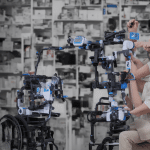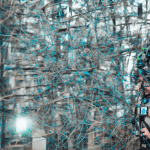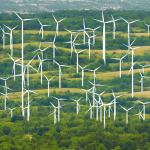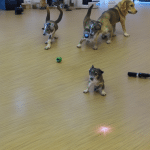Artificial intelligence (AI) has been instrumental in shaping the modern world. From automated systems to smart technology, its influence is growing exponentially. Among the many sectors benefiting from AI, the drone industry is experiencing an unparalleled revolution. Drones equipped with AI, powered by advanced algorithms, and integrated with machine learning processes, present a wealth of potential applications and challenges that we need to address.
The Integration of AI in Drone Technology
AI integration into drone technology is a remarkable innovation that continues to redefine what these autonomous flying machines can do. The coalescence of drone functionalities with AI has propelled the drone industry into a new era of technology where possibilities seem limitless. Let’s delve into how AI is integrating into drone technology and how it impacts their functionality.
Cela peut vous intéresser : How Is the Drone Hobbyist Community Influencing Drone Technology?
Traditionally, drones were primarily used for simple tasks such as aerial photography and videography. However, with AI integration, drones are now equipped to carry out sophisticated operations. These include real-time data collection and analysis, autonomous navigation, object recognition, and even predictive maintenance. The AI algorithms equip the drones to learn from their encounters and improve their accuracy and efficiency over time.
Machine learning, a subset of AI, is a vital player in this integration. Through machine learning, drones can collect vast amounts of data, analyze this data, and make decisions based on the collected information. This ability drastically enhances the autonomous capabilities of drones, allowing them to perform tasks independently.
A lire également : What Are the Prospects for Drone-Based Delivery Systems in Urban Environments?
Potential Applications of AI-powered Drones
AI-powered drones are not just a theoretical concept; they are already being employed in various sectors, pushing the boundaries of what is possible. So, what are the potential real-world applications of these drones, and how are they revolutionizing different industries?
In agriculture, AI-powered drones can monitor crop health, predict yields, and even aid in crop dusting. Through real-time data collection and analysis, farmers can implement precision agriculture practices, leading to increased productivity and reduced environmental impact.
The construction industry too is realizing the benefits of incorporating AI-equipped drones into their operations. These drones can perform site surveys, monitor construction progress, identify potential hazards, and help in project management. They can carry out these tasks more quickly and accurately than human workers, leading to significant time and cost savings.
Emergency response teams are also employing AI-powered drones. In disaster-struck areas, drones can map the terrain, locate survivors, and deliver essential supplies. The real-time data collected by drones can assist in planning and executing rescue operations more efficiently.
Challenges in Implementing AI in Drones
While AI-powered drones hold significant promise, there are also notable challenges in their implementation. Understanding these potential hurdles is crucial in realizing the full potential of this technology.
Regulatory hurdles pose the most significant challenge. Drones operate in shared airspace, and their operation is governed by aviation authorities worldwide. As AI allows drones to perform more complex tasks autonomously, it raises concerns regarding safety, privacy, and accountability. Ensuring these drones operate within set rules and regulations, while not stifling innovation, is a delicate balance that authorities need to achieve.
Technical challenges are also abundant. AI requires significant processing power, which could lead to increased power consumption and reduced flight time for drones. Additionally, ensuring the drone’s AI systems can function effectively under various environmental conditions is another significant challenge.
The Future of AI in Drones
Given the current rate of technological advancements, the future of AI in drones looks promising, albeit with its fair share of challenges. So, what could the future hold for AI-equipped drones, and how could they continue to impact our lives?
Researchers are currently developing drones that can interact and cooperate with each other. These swarms of drones, coordinated by AI, could carry out complex tasks more efficiently than individual drones. Imagine a swarm of drones working together to map a disaster-stricken area, or a team of drones collaboratively constructing a building. The possibilities are indeed endless.
Furthermore, with advances in AI and machine learning, drones could become completely autonomous. Currently, most drones still require some level of human intervention. In the future, drones could independently carry out all their operations, from takeoff to landing and everything in between.
It is evident that the integration of AI in drone technology is reshaping their capabilities and applications. While the road ahead is filled with challenges, the prospects are exciting and full of potential. As we continue to explore and develop AI-powered drones, we are only limited by our imagination.
AI in Drone Technology: A Game Changer for Search & Rescue Operations
Artificial intelligence and drone technology are increasingly becoming a game-changer for search and rescue operations. The fusion of AI and drone technology has made it possible for drones to perform tasks that were once considered impossible, such as searching for lost or missing persons in challenging terrains, delivering emergency supplies to disaster-stricken areas, and assisting in firefighting operations.
AI-powered drones are equipped with advanced capabilities such as real-time data collection and obstacle avoidance. Using machine learning algorithms, these drones can autonomously navigate through complex environments, identifying and avoiding obstacles in their path. This capability is particularly beneficial in search and rescue operations, where time is of the essence, and the terrain may be difficult or dangerous for humans to traverse.
The computer vision feature in these drones, powered by AI, enables them to recognize objects and individuals accurately. This is crucial in locating lost or missing persons in vast, challenging terrains. Moreover, these drones can operate in various weather conditions and even during the night, thanks to their infrared sensors.
Another significant advantage of AI-powered drones in search and rescue operations is their ability to make autonomous decision making. Using the real-time data they collect, these drones can determine the most efficient path to reach a target, the best way to deliver supplies, or the safest route to evacuate victims.
However, these benefits also come with ethical considerations. Questions of privacy and data security arise with the use of drones equipped with cameras and data collection capabilities. Therefore, it is vital to ensure that these technologies are used responsibly and in compliance with privacy laws and regulations.
Autonomous Drones and the Future of the Drone Industry
Looking forward, AI’s role in enhancing drone functionality is expected to grow significantly, particularly in the development of autonomous drones. These drones will be capable of independently performing tasks from take-off to landing without human intervention.
Using advanced machine learning algorithms, these drones will continuously learn from their encounters, improving their efficiency and accuracy over time. This ability will make them invaluable in industries such as agriculture and construction, where precision and efficiency are crucial.
The concept of drone swarms, where multiple drones work together to perform a task, is another area being explored. Coordinated by AI, these drone swarms could carry out complex tasks more effectively than individual drones. They could be used in various applications, from disaster response and precision agriculture to construction and delivery services.
Despite the potential of AI-powered drones, challenges remain. Regulatory hurdles and privacy concerns pose significant obstacles. Balancing the need for innovation with safety and privacy considerations will be a key challenge for the drone industry. Additionally, technical issues such as power consumption, resource allocation, and ensuring the drone’s AI systems can function effectively under various environmental conditions need to be addressed.
Conclusion
In conclusion, the future of AI in enhancing drone functionality looks promising. The integration of AI into drone technology has opened up a wealth of possibilities, from improving efficiency in agriculture and construction to revolutionizing search and rescue operations. With advancements in machine learning and AI, drones are becoming increasingly autonomous, capable of performing complex tasks independently.
However, as we venture into this new frontier, we must address the challenges that come with it. Regulatory issues, privacy concerns, and technical challenges must be tackled to fully realize the potential of AI-powered drones. As the drone industry continues to evolve, we can expect AI to play an increasingly central role in shaping its future.











